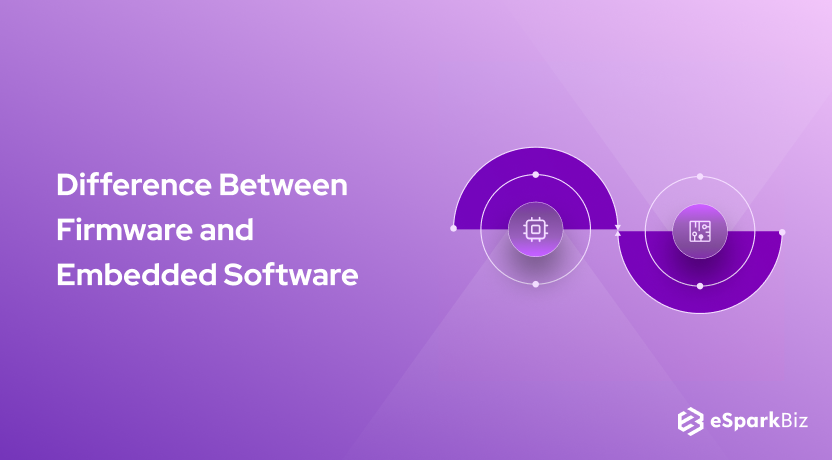Software technology has risen to extreme heights since its beginning. What started as simple logic has changed into large and complex codes that can control everything from businesses to factories and even mechanical machines.
Two such software categories that are unclear to the general public are firmware and embedded software. Both these look pretty similar from the top, and hence they are often used interchangeably. Today, we’ll debug these two and do a head-to-head firmware vs. embedded software comparison.
Let’s start off with Firmware.
What Is Firmware?

Firmware is found in almost all available devices like microwaves, washing machines, refrigerators, and others. These devices need to be controlled by a microcontroller, and Firmware helps here.
Firmware acts as a bridge between the hardware and other software applications that power a machine.
Firmware is software that lies at the core and drives everything that can take instructions. It enables communication between humans and machines. As the device changes, its firmware changes, and due to this, every device has different firmware.

While designing software, custom software development firm need to consider the characteristics they want to give to the machine. Like what power they want to give to the machine by programming it. The capabilities of the machine can change based on its nature. If it is a washing machine, the Firmware needs to have programs that enable the movement of different washing machine parts.
Having known what Firmware is, it is good to know the benefits of Firmware.
Benefits of Firmware
Security

Firmware is the ultimate security layer for all things in tech. It acts as a bridge between the hardware and software and makes a curtain between both of these. Due to this, no one can directly interact with the hardware components, even if they break into the software’s code.
A secure firmware is really helpful in maintaining a sound system.
Cost-Effective
From a consumer’s point of view, Firmware is cost-effective. Using Firmware in the devices, customers can enjoy the latest software features without having to upgrade to a new device. Consumers can get the Firmware upgraded, and they’ll get features that are precisely similar to the new devices.
People change devices just for newer features, including Firmware makes it cost-effective for them because they don’t have to spend a lot of money every now and then for new features.
Also Read: How to Estimate Custom Software Development Costs
Enable Hardware and Software Communication

Firmware is a layer of software that allows all other software to run on top of it. Without Firmware, hardware cannot be controlled in most devices. Hence, it acts as a bridge between hardware and software.
Firmware is written in a low-level language with a program logic that enables direct controlling of circuits and other hardware components. With its program logic, Firmware helps software instructions to be performed on the hardware part. This way, it establishes much helpful communication.
Now, you know precisely what Firmware is, so it is time to move on to the next topic, embedded software.
What is Embedded Software?

As the name suggests, embedded software is embedded inside systems. Such software is used to control different parts of a mechanical or hardware system.
Embedded software is a software application that runs on top of the Firmware to provide unique features to the embedded device. Embedded software is all around you, starting from an mp3 player to a washing machine and even more.
Embedded software files are placed in the device’s memory, and they are executed as other software on a required basis. Whenever any functionality needs to be performed, the piece of software can be executed, and the function can be performed easily.
Here are some benefits and advantages of embedded software.
Benefits of Embedded Software
Easier To Configure
Once the Firmware and its design are ready, it becomes easier to configure embedded software. As embedded software runs on top of Firmware, having well-developed Firmware is a must. With suitable Firmware, embedded software can be easily installed and set up for performing extra functions on the hardware or mechanical parts.
Custom Programs, Increased Functionality
Embedded software for every set of devices is different. As the device’s requirements change, the software also changes. This means that no two categories of devices have the same software.
Embedded software is customized; hence the functionality is also increased. Moreover, Firmware can perform many functionalities, but people prefer embedded software to add even more functionalities to it.
Updatable
Embedded software works like other software offerings, so it is easier to update. Firmware updates are complicated, as they can even break the system. But there are no such chances with embedded software updates.
Today, embedded software updates are delivered over the air; hence, anyone can download them and update their devices. Due to this, the systems stay updated and secure all time.
Having known about both the topics. Now you should have a look at the Firmware Vs. Embedded software comparison.
Difference Between Firmware And Embedded Software
Development Language
The languages used in the development of Firmware and embedded software are different. As Firmware needs to control and interact with devices such as circuits, gates, and other things, they are usually developed in low-level languages that help in direct interaction with devices.
On the other hand, embedded software is just like other software pieces in the market, so it can be developed using any high-level language. Famous high-level languages in the development of embedded software are C++ and Java.
Also Read: Reasons Why Python Programming Language Is Favorite Of Developers
Device Support
This is one of the most distinguishing factors between these two topics. The devices that these software topics support are entirely different, and by looking at the devices, you can understand the difference between Firmware and embedded software.
Firmware is usually found on general-purpose computing devices like computers, mobile phones, tablets, laptops, etc. Such devices can perform multiple functionalities; hence they need Firmware that can provide a base for all the other software.
In contrast, embedded software is used to control devices with a specific purpose. Such devices have only core functionality, and they stick to performing it. Embedded software is used in devices like mp3 players, whose core functionality is to play music. It is used in household appliances like washing machines, refrigerators, dishwashers, grinders, etc.
Presence of Other Software
In a firmware scenario, it is never the only software on a system. As discussed earlier, it acts as a base for all other software to be installed on the system.
While in an embedded software scenario, it is usually the only software that runs the system. It controls all the functionalities of the system single-handedly and does not allow interference.
Also Read: Freelancer vs Software Development Agency
Easier To Update
Today, both embedded software and Firmware can be updated over the air. The difference here lies in the easiness of updating. Firmware updates are tricky, and without an experienced person, there are too many dangers involved. Moreover, if the firmware update fails, the whole system can go down. This makes it quite hard to update the Firmware.
Embedded software, on the other hand, is relatively easier to update. You can download the update package and install it on your own. It is easier to update embedded software compared to Firmware because here, the risks involved are light. Failure in embedded software updates doesn’t stop the machine’s functionality.
Coming to an end today, you’ve paved your way through two of the most confusing topics. Keep these differences in mind to always distinguish between Firmware Vs. Embedded software.








